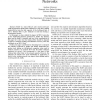Free Online Productivity Tools
i2Speak
i2Symbol
i2OCR
iTex2Img
iWeb2Print
iWeb2Shot
i2Type
iPdf2Split
iPdf2Merge
i2Bopomofo
i2Arabic
i2Style
i2Image
i2PDF
iLatex2Rtf
Sci2ools
LCN
2008
IEEE
2008
IEEE
On measuring available bandwidth in wireless networks
Abstract— BART is a state-of-the-art active end-to-end bandwidth measurement method that estimates not only the available bandwidth but also the link capacity of the bottleneck link. It uses a Kalman filter to give estimates in real time during a measurement session. In this paper, we have studied the impact of 802.11 networks on the bandwidth estimates produced by BART. The Kalman filter used by BART is tunable, and one of the contributions of this paper is to show how the Kalman filter should be adjusted to improve real-time tracking and estimation accuracy when the bottleneck is an 802.11 link. Further, the paper contributes by discussing how to interpret the estimates produced by BART and similar bandwidth estimation tools relying on self-induced congestion when used in wireless scenarios. An analysis show that the BART estimates produced are correct - but corresponds to a fair share of the wireless link rather than to the unused capacity. However, the estimates do indicate ho...
| Added | 31 May 2010 |
| Updated | 31 May 2010 |
| Type | Conference |
| Year | 2008 |
| Where | LCN |
| Authors | Andreas Johnsson, Mats Björkman |
Comments (0)

